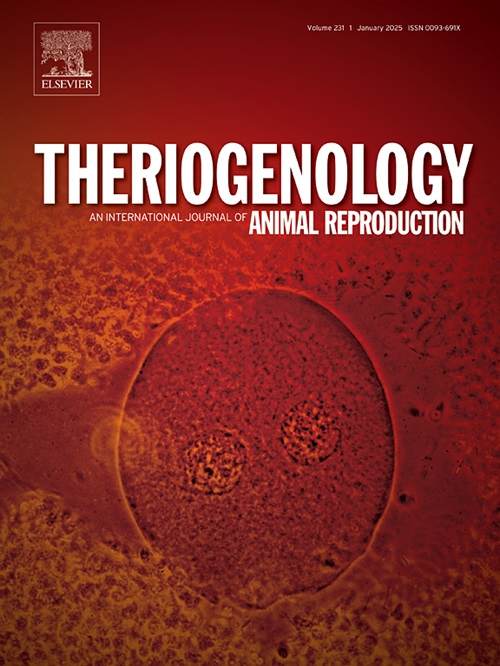EGCG通过DRD2受体介导对4°C液体储存期间猪精子质量的有益影响。
IF 2.4
2区 农林科学
Q3 REPRODUCTIVE BIOLOGY
引用次数: 0
摘要
表没食子儿茶素没食子酸酯(EGCG)是一种天然抗氧化剂,在调节精子功能中起着至关重要的作用,但其在4°C液体保存过程中对猪精子的保护作用尚不清楚。本研究旨在探讨EGCG对公猪精液保存的有益作用,并阐明其可能的作用机制。采用计算机辅助精液分析系统、Western blot和分子对接技术分析精子质量、抗氧化状态、蛋白磷酸化水平、膜受体和环腺苷单磷酸/蛋白激酶A (cAMP/PKA)信号通路等多个参数。结果表明,添加EGCG,特别是添加10 μg/mL时,显著提高了精子活力、顶体完整性、线粒体膜电位和细胞内ATP含量。此外,EGCG通过消除过多的活性氧来增强精子的抗氧化能力。有趣的是,EGCG的抗氧化特性部分地阻止了蛋白质的去磷酸化,从而间接地增强了蛋白质的磷酸化。此外,在猪精子中检测到多巴胺受体(DRD2),抑制DRD2可显著阻止EGCG引起的蛋白磷酸化水平和精子活力的增强,提示DRD2在调节EGCG的有益作用中发挥作用。分子对接结果表明,EGCG与DRD2活性位点具有良好的结合作用,包括关键的氢键和疏水相互作用,进一步表明EGCG可能直接与DRD2相互作用,通过激活DRD2/cAMP/PKA通路介导蛋白磷酸化,从而增强精子活力。本研究首次探索了EGCG与猪精子细胞表面受体的相互作用,为EGCG在低温液体储存过程中的保护机制提供了全面的见解。本文章由计算机程序翻译,如有差异,请以英文原文为准。

Beneficial effects of EGCG on boar sperm quality during liquid storage at 4 °C are mediated by DRD2 receptor
Epigallocatechin gallate (EGCG), a natural antioxidant, plays a vital role in modulating sperm function, yet its protective impact on boar spermatozoa during liquid preservation at 4 °C remains elusive. This study aimed to investigate the beneficial effects of EGCG on boar semen preservation, and elucidate the potential mechanism. Multiple parameters including sperm quality, anti-oxidative status, protein phosphorylation levels, membrane receptor and cyclic adenosine monophosphate/protein kinase A (cAMP/PKA) signaling pathways were analyzed using computer-assisted semen analysis system, Western blot and molecular docking techniques. Results revealed that supplementation with EGCG, particularly with 10 μg/mL, significantly increased sperm motility, acrosome integrity, mitochondrial membrane potential and intracellular ATP content. Moreover, EGCG enhanced the antioxidant defenses of sperm through eliminating excessive reactive oxygen species. Intriguingly, the antioxidant property of EGCG partly prevented protein dephosphorylation, thereby indirectly enhancing protein phosphorylation. Additionally, the dopamine receptor (DRD2) was detected in boar spermatozoa and inhibition of DRD2 greatly prevented EGCG-caused enhancement of protein phosphorylation levels and sperm motility, suggesting the role of DRD2 in regulation of the beneficial effects of EGCG. Molecular docking results indicated that EGCG has favorable binding interactions with the active sites of DRD2, involving crucial hydrogen bonding and hydrophobic interactions, further suggesting that EGCG might directly interact with DRD2, mediate protein phosphorylation via activating the DRD2/cAMP/PKA pathway and thus boost sperm motility. The present study is the first to explore the interacting cell-surface receptor of EGCG on boar sperm and provides comprehensive insights into the protective mechanism of EGCG during hypothermic liquid storage.
求助全文
通过发布文献求助,成功后即可免费获取论文全文。
去求助
来源期刊

Theriogenology
农林科学-生殖生物学
CiteScore
5.50
自引率
14.30%
发文量
387
审稿时长
72 days
期刊介绍:
Theriogenology provides an international forum for researchers, clinicians, and industry professionals in animal reproductive biology. This acclaimed journal publishes articles on a wide range of topics in reproductive and developmental biology, of domestic mammal, avian, and aquatic species as well as wild species which are the object of veterinary care in research or conservation programs.
 求助内容:
求助内容: 应助结果提醒方式:
应助结果提醒方式:


